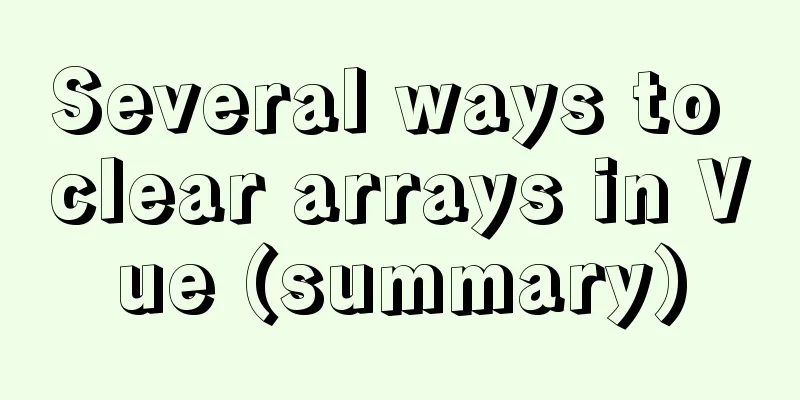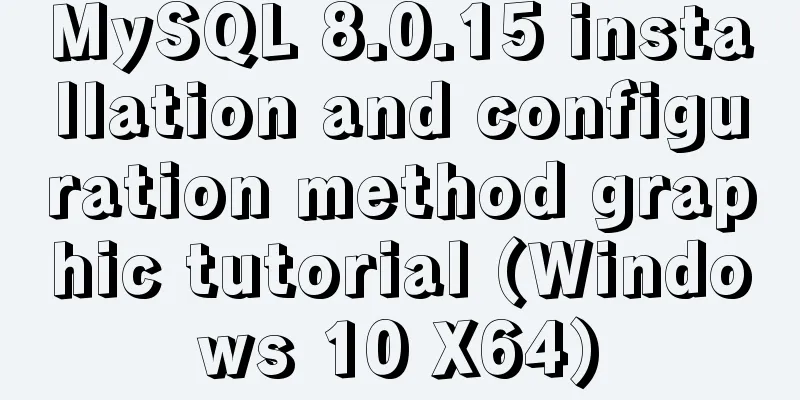Explanation and example usage of 4 custom instructions in Vue

|
Four practical vue custom instructions 1. v-dragRequirement: Mouse drag element Ideas: Element offset = coordinates after mouse sliding - coordinates when the mouse initially clicks the element + top and left distance of the element from the visible area at the time of initial click. Code:
Vue.directive('drag', {
inserted(el) {
let header = el.querySelector('.dialog_header')
header.style.cssText += ';cursor:move;'
header.onmousedown = function (e) {
//Get the width and height of the current visible area let clientWidth = document.documentElement.clientWidth
let clientHeight = document.documentElement.clientHeight
//Get its own width and height let elWidth = el.getBoundingClientRect().width
let elHeight = el.getBoundingClientRect().height
//Get the top and left of the current distance visible area
let elTop = el.getBoundingClientRect().top
let elLeft = el.getBoundingClientRect().left
//Get the coordinates when clicking let startX = e.pageX
let startY = e.pageY
document.onmousemove = function (e) {
//Element offset = coordinates after mouse sliding - coordinates when mouse initially clicks element + top and left distance of element from visible area at initial click
let moveX = e.pageX - startX + elLeft
let moveY = e.pageY - startY + elTop
//Use the visible area as the boundary and limit dragging within the visible area if ((moveX + elWidth) > clientWidth || moveX < 0 || (moveY + elHeight) > clientHeight || moveY < 0) {
return
}
el.style.cssText += 'top:' + moveY + 'px;left:' + moveX + 'px;'
}
document.onmouseup = function () {
document.onmousemove = null
document.onmouseup = null
}
}
}
})2. v-wordlimitRequirements: The background field has a length limit and distinguishes between Chinese and English. Chinese is two bytes and English is one byte. Therefore, the input box needs to limit the number of characters entered and distinguish the number of bytes, and the number of characters entered needs to be echoed. Ideas: One-byte regular expression /[\x00-\xff]/g Create an element that wraps the word limit and position it on the textarea and input box Calculate the number of input characters, enLen for one-byte characters and cnLen for two-byte characters; this is used for string truncation processing later. When the number of characters input exceeds the limit, truncation is performed; substr(0,enLen+cnLen) The interface updates the value of the input box, or initializes the value of the input box, and needs to echo the correct number of bytes Code:
Vue.directive('wordlimit',{
bind(el,binding){
console.log('bind');
let { value } = binding
Vue.nextTick(() => {
//Find out whether the input box is a textarea box or an input box let current = 0
let arr = Array.prototype.slice.call(el.children)
for (let i = 0; i < arr.length; i++) {
if(arr[i].tagName=='TEXTAREA' || arr[i].tagName=='INPUT'){
current = i
}
}
//Update the number of bytes in the current input box el.children[el.children.length-1].innerHTML = el.children[current].value.replace(/[^\x00-\xff]/g,'**').length +'/'+value//eslint-disable-line
})
},
update(el,binding){
console.log('update');
let { value } = binding
Vue.nextTick(() => {
//Find out whether the input box is a textarea box or an input box let current = 0
let arr = Array.prototype.slice.call(el.children)
for (let i = 0; i < arr.length; i++) {
if(arr[i].tagName=='TEXTAREA' || arr[i].tagName=='INPUT'){
current = i
}
}
//Update the number of bytes in the current input box el.children[el.children.length-1].innerHTML = el.children[current].value.replace(/[^\x00-\xff]/g,'**').length +'/'+value//eslint-disable-line
})
},
inserted(el,binding){
console.log('inserted');
let { value } = binding
//Find out whether the input box is a textarea box or an input box let current = 0
let arr = Array.prototype.slice.call(el.children)
for (let i = 0; i < arr.length; i++) {
if(arr[i].tagName=='TEXTAREA' || arr[i].tagName=='INPUT'){
current = i
}
}
//Create an element that wraps the word limit and positions it on the textarea and input box let div = document.createElement('div')
if(el.children[current].tagName=='TEXTAREA'){//It is textarea, positioned in the lower right corner div.style = 'color:#909399;position:absolute;font-size:12px;bottom:5px;right:10px;'
}else{
let styStr = ''
if(!el.classList.contains('is-disabled')){//If the input box is not grayed out, add background color styStr = 'background:#fff;'
}
div.style = 'color:#909399;position:absolute;font-size:12px;bottom:2px;right:10px;line-height:28px;height:28px;'+styStr
}
div.innerHTML = '0/' + value
el.appendChild(div)
el.children[current].style.paddingRight = '60px'
el.oninput = () => {
let val = el.children[current].value
val = val.replace(/[^\x00-\xff]/g,'**') //eslint-disable-line
// The word limit box is inserted into el as the last element el.children[el.children.length-1].innerHTML = val.length + '/' + value
if(val.length>value){
let cnLen = 0 //Number of one-byte words let enLen = 0 //Number of two-byte words if(val.match(/[^**]/g) && val.match(/[^**]/g).length){
enLen = val.match(/[^**]/g).length // Calculate the number of words in a byte // A byte has both bytes if((value - val.match(/[^**]/g).length)>0){
cnLen = Math.floor((value - val.match(/[^**]/g).length)/2)
}else{
cnLen = 0
}
}else{ //For both bytes enLen = 0
cnLen = Math.floor(value/2)
}
if(enLen>value){
enLen = value
}
//If the number of bytes exceeds the limit, intercept el.children[current].value = el.children[current].value.substr(0,enLen+cnLen)
//Update the number of bytes in the current input box el.children[el.children.length-1].innerHTML = el.children[current].value.replace(/[^\x00-\xff]/g,'**').length +'/'+value//eslint-disable-line
}
}
},
})use: <el-input type="textarea" rows="3" v-wordlimit="20" v-model="value"></el-input> 3. v-anthorRequirement: Click an element (usually a title, subtitle, etc.) and the animation scrolls to the corresponding content block Ideas: Timer using window.scrollBy If you don't consider IE, you can directly use window.scrollBy({ top: ,left:0,behavior:'smooth' }) Code:
Vue.directive('anchor',{
inserted(el,binding){
let { value } = binding
let timer = null
el.addEventListener('click',function(){
// The distance between the current element and the top of the visible area let currentTop = el.getBoundingClientRect().top
animateScroll(currentTop)
},false)
function animateScroll(currentTop){
if(timer){
clearInterval(timer)
}
let c = 9
timer = setInterval(() => {
if(c==0){
clearInterval(timer)
}
c--
window.scrollBy(0,(currentTop-value)/10)
},16.7)
}
}
})use: <div class="box" v-anchor="20" style="color:red;">Yes</div> 4. v-hasRoleRequirements: Add or delete corresponding elements according to system roles Code:
Vue.directive('hasRole',{
inserted(el,binding){
let { value } = binding
let roles = JSON.parse(sessionStorage.getItem('userInfo')).roleIds
if(value && value instanceof Array && value.length>0){
let hasPermission = value.includes(roles)
if(!hasPermission){
el.parentNode && el.parentNode.removeChild(el)
}
}else{
throw new Error(`Please check the expression bound to the instruction, the correct format is such as v-hasRole="['admin','reviewer']"`)
}
}
})This concludes this article about the explanation and example usage of 4 custom instructions in Vue. For more information about the 4 custom instructions in Vue that are worth knowing, please search for previous articles on 123WORDPRESS.COM or continue to browse the following related articles. I hope you will support 123WORDPRESS.COM in the future! You may also be interested in:
|
<<: How to use HTML form with multiple examples
Recommend
Detailed explanation of COLLATION examples in MySQL that you may have overlooked
Preface The string types of MySQL database are CH...
Solution to the network failure when installing workstation in a virtual machine in ESXI
Problem Description After installing workstations...
How to check the hard disk size and mount the hard disk in Linux
There are two types of hard disks in Linux: mount...
The pitfalls and solutions caused by the default value of sql_mode in MySQL 5.7
During normal project development, if the MySQL v...
Detailed explanation of how to install MySQL on Alibaba Cloud
As a lightweight open source database, MySQL is w...
Solution to the problem that Vue binding objects and array variables cannot be rendered after changing
Project scenario: There is a <ul> tag on th...
Teach you how to use vscode to build a react-native development environment
question The code has no prompt: Many non-front-e...
Detailed process of getting started with docker compose helloworld
Prerequisites Compose is a tool for orchestrating...
Windows Server 2016 Quick Start Guide to Deploy Remote Desktop Services
Now 2016 server supports multi-site https service...
Vue project realizes paging effect
The paging effect is implemented in the vue proje...
Detailed explanation of front-end security: JavaScript anti-http hijacking and XSS
Table of contents HTTP hijacking, DNS hijacking a...
Complete steps to use samba to share folders in CentOS 7
Preface Samba is a free software that implements ...
Design Tips: We think you will like it
<br />Looking at this title, you may find it...
Detailed explanation of Navicat's slow remote connection to MySQL
The final solution is in the last picture If you ...
CSS scroll bar style modification code
CSS scroll bar style modification code .scroll::-...









